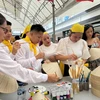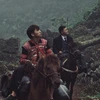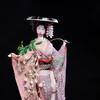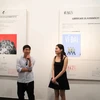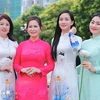 The 75-year-old village patriarch named Ak prepares a new wooden statue for a ‘Po thi’ ceremony. He and young men of the Jarai community from the Central Highlands province of Gia Lai got up early to make offerings for this ceremony, an important festival of their ethnic group. In the minority’s culture, when a person passes away, he/she will be buried in a makeshift grave, and relatives will ‘feed’ the deceased every day through a long tube put deeply into the grave. They believe that before the grave-abandoning ceremony, the deceased still exists nearby, comes home, and also needs food. The dead can leave this world and reach the afterlife only when this ceremony takes place. (Photo: VietnamPlus)
The 75-year-old village patriarch named Ak prepares a new wooden statue for a ‘Po thi’ ceremony. He and young men of the Jarai community from the Central Highlands province of Gia Lai got up early to make offerings for this ceremony, an important festival of their ethnic group. In the minority’s culture, when a person passes away, he/she will be buried in a makeshift grave, and relatives will ‘feed’ the deceased every day through a long tube put deeply into the grave. They believe that before the grave-abandoning ceremony, the deceased still exists nearby, comes home, and also needs food. The dead can leave this world and reach the afterlife only when this ceremony takes place. (Photo: VietnamPlus)  Ak prepares offerings for worship rituals. To prepare for the grave-abandoning ceremony, Jarai people often go to seek timber, bamboo, rattan, and grass in the forest to build a charnel house. After that, they bury some assets together with the dead in the charnel house, from valuable objects like gongs, jars, bead bracelets to weapons, farm tools, and daily items like pots and bowls. The objects buried with the dead vary, depending on each family’s circumstances. Besides, the ethnic group also makes wooden statues placed around the charnel house. These statues depict people of different genders, ages, and in different postures, reflecting the circle of life. (Photo: VietnamPlus)
Ak prepares offerings for worship rituals. To prepare for the grave-abandoning ceremony, Jarai people often go to seek timber, bamboo, rattan, and grass in the forest to build a charnel house. After that, they bury some assets together with the dead in the charnel house, from valuable objects like gongs, jars, bead bracelets to weapons, farm tools, and daily items like pots and bowls. The objects buried with the dead vary, depending on each family’s circumstances. Besides, the ethnic group also makes wooden statues placed around the charnel house. These statues depict people of different genders, ages, and in different postures, reflecting the circle of life. (Photo: VietnamPlus)  Some statues with a sad facial expression placed outside a charnel house. Traditionally, men are responsible for building the charnel house while women are only in charge of serving meals for them. It often takes Jarai people an entire week, even a month, to complete a charnel house. Residents in the same village also come to help the bereaved family with the construction. The grave-abandoning ceremony takes place after one - three years since the death of a person. Poor families often ‘feed the dead’ for one year while this practice lasts for up to three years in richer families before the ‘po thi’ ceremony is organised. (Photo: VietnamPlus)
Some statues with a sad facial expression placed outside a charnel house. Traditionally, men are responsible for building the charnel house while women are only in charge of serving meals for them. It often takes Jarai people an entire week, even a month, to complete a charnel house. Residents in the same village also come to help the bereaved family with the construction. The grave-abandoning ceremony takes place after one - three years since the death of a person. Poor families often ‘feed the dead’ for one year while this practice lasts for up to three years in richer families before the ‘po thi’ ceremony is organised. (Photo: VietnamPlus)  The village patriarch says prayers to the gods and the dead before officially conducting rituals. Only patriarchs respected by the whole village like Ak are entrusted with chairing the grave-abandoning ceremony. He said this ceremony is very important to the ethnic group. Jarai people attach importance to the bonds among them. During the mourning period that lasts for one to three years, members of the bereaved family must not wear new clothes, use new objects, or go on holiday, which is a strict rule seriously observed by the community. Only after the grave-abandoning ceremony finishes can the mourning period is considered over. (Photo: VietnamPlus)
The village patriarch says prayers to the gods and the dead before officially conducting rituals. Only patriarchs respected by the whole village like Ak are entrusted with chairing the grave-abandoning ceremony. He said this ceremony is very important to the ethnic group. Jarai people attach importance to the bonds among them. During the mourning period that lasts for one to three years, members of the bereaved family must not wear new clothes, use new objects, or go on holiday, which is a strict rule seriously observed by the community. Only after the grave-abandoning ceremony finishes can the mourning period is considered over. (Photo: VietnamPlus)  Young men in the village coat themselves with mud and wear masks to disguise as ‘Bram’ (ghosts) and dance in the ‘po thi’ ceremony. Saying prayers while pouring alcohol onto the ground, the patriarch told the spirit that the charnel house is built for the dead and from this ceremony onwards, the dead should leave his/her descendants and ask gods for food as the living will no longer bring meals to him/her. Despites numerous ups and downs in history, Jarai people have still maintained their cultural identity and treasured community values, which in turn has contributed to the diversity but also unity of the Vietnamese culture. (Photo: VietnamPlus)
Young men in the village coat themselves with mud and wear masks to disguise as ‘Bram’ (ghosts) and dance in the ‘po thi’ ceremony. Saying prayers while pouring alcohol onto the ground, the patriarch told the spirit that the charnel house is built for the dead and from this ceremony onwards, the dead should leave his/her descendants and ask gods for food as the living will no longer bring meals to him/her. Despites numerous ups and downs in history, Jarai people have still maintained their cultural identity and treasured community values, which in turn has contributed to the diversity but also unity of the Vietnamese culture. (Photo: VietnamPlus)  Young men in the village play gongs in the ‘po thi’ ceremony, which is also an important festival of the Jarai ethnic group. The grave-abandoning ceremony often lasts for three days, and relatives of the dead keep a vigil at the charnel house every night during this time. When the patriarch finishes worship rituals, relatives of the deceased also come to the charnel house to mourn him/her for the last time. In the last night of the ceremony, a large performance is held around the tomb. Participants in solemn but also colourful clothes play gongs and drums, perform puppets, and dance together to send the dead to the afterlife. (Photo: VietnamPlus)
Young men in the village play gongs in the ‘po thi’ ceremony, which is also an important festival of the Jarai ethnic group. The grave-abandoning ceremony often lasts for three days, and relatives of the dead keep a vigil at the charnel house every night during this time. When the patriarch finishes worship rituals, relatives of the deceased also come to the charnel house to mourn him/her for the last time. In the last night of the ceremony, a large performance is held around the tomb. Participants in solemn but also colourful clothes play gongs and drums, perform puppets, and dance together to send the dead to the afterlife. (Photo: VietnamPlus)  Jarai girls perform a traditional dance. After the ceremony, people join in a party, play gongs, and dance. The ‘po thi’ ceremony is a festival that boasts not only artistic values but also humanism as it highlights the bonds in families and the community. Jarai is one of the 54 ethnic groups in Vietnam. It is also known by some other names such as Gio Rai, Cho Rai, To Buan, Hobau, Hdrung, and Chor. Jarai people mainly reside in Gia Lai province, part of Kon Tum Province, and the north of Dak Lak province, all of which are in the Central Highlands. (Photo: VietnamPlus)
Jarai girls perform a traditional dance. After the ceremony, people join in a party, play gongs, and dance. The ‘po thi’ ceremony is a festival that boasts not only artistic values but also humanism as it highlights the bonds in families and the community. Jarai is one of the 54 ethnic groups in Vietnam. It is also known by some other names such as Gio Rai, Cho Rai, To Buan, Hobau, Hdrung, and Chor. Jarai people mainly reside in Gia Lai province, part of Kon Tum Province, and the north of Dak Lak province, all of which are in the Central Highlands. (Photo: VietnamPlus)  The patriarch distributes offerings in the grave-abandoning ceremony to residents in the village after worship rituals finish. The Jarai people form one of the most populous ethnic minority groups in the Central Highlands, with a population of over 500,000. Their language belongs to the Malayo-Polynesian branch of the Austronesian language family. It is related to the Cham language in central Vietnam. Long epics and old tales such as ‘Dam Di di san’ (Dam Di goes hunting) and ‘Xinh Nha’ are very popular in the community. Their outstanding musical instruments include gongs, T'rung, To-Nung, and Krong-Put. Meanwhile, their garments resemble costumes of many other ethnic groups in the Central Highlands. (Photo: VietnamPlus)
The patriarch distributes offerings in the grave-abandoning ceremony to residents in the village after worship rituals finish. The Jarai people form one of the most populous ethnic minority groups in the Central Highlands, with a population of over 500,000. Their language belongs to the Malayo-Polynesian branch of the Austronesian language family. It is related to the Cham language in central Vietnam. Long epics and old tales such as ‘Dam Di di san’ (Dam Di goes hunting) and ‘Xinh Nha’ are very popular in the community. Their outstanding musical instruments include gongs, T'rung, To-Nung, and Krong-Put. Meanwhile, their garments resemble costumes of many other ethnic groups in the Central Highlands. (Photo: VietnamPlus)  Guests are invited to taste ‘ruou can’ (wine drunk out of a jar through pipes) and attend the festival. Jarai people live on slash-and-burn cultivation and terraced fields, with rice being their staple food. They also breed elephants. Jarai men are very skillful in basketry while women in cloth weaving. Hunting, gathering, and fishing are other sideline occupations. The ethnic group believes in the existence of ‘Giang’ (genies) and hold many rituals connected to their genies. They live in separate villages called ‘ploi’ or ‘bon’. Their houses are built on stilts. Village chiefs and patriarchs have great prestige in the Jarai society and play an important role in running collective activities. (Photo: VietnamPlus)
Guests are invited to taste ‘ruou can’ (wine drunk out of a jar through pipes) and attend the festival. Jarai people live on slash-and-burn cultivation and terraced fields, with rice being their staple food. They also breed elephants. Jarai men are very skillful in basketry while women in cloth weaving. Hunting, gathering, and fishing are other sideline occupations. The ethnic group believes in the existence of ‘Giang’ (genies) and hold many rituals connected to their genies. They live in separate villages called ‘ploi’ or ‘bon’. Their houses are built on stilts. Village chiefs and patriarchs have great prestige in the Jarai society and play an important role in running collective activities. (Photo: VietnamPlus)  Young men disguise as ‘Bram’ (ghosts) to send the soul of the dead to the afterlife. Each village of the Jarai ethnic group has a communal house called ‘rong’. A matriarchal regime is practiced by Jarai people. Women are free to choose their lovers and decide who they marry. The husband lives with his wife's family and has no rights to inheritance. There are many rituals in the wedding ceremony, which is held in both families. Meanwhile, the daughter, after marriage, will no longer live with her parents or inherit from them. Children take the family name of their mother. Apart from the grave-abandoning ceremony, other notable events include the new house and new rice ceremonies. (Photo: VietnamPlus)
Young men disguise as ‘Bram’ (ghosts) to send the soul of the dead to the afterlife. Each village of the Jarai ethnic group has a communal house called ‘rong’. A matriarchal regime is practiced by Jarai people. Women are free to choose their lovers and decide who they marry. The husband lives with his wife's family and has no rights to inheritance. There are many rituals in the wedding ceremony, which is held in both families. Meanwhile, the daughter, after marriage, will no longer live with her parents or inherit from them. Children take the family name of their mother. Apart from the grave-abandoning ceremony, other notable events include the new house and new rice ceremonies. (Photo: VietnamPlus)  Young men, coating themselves with mud to disguise as ‘Bram’, dance in the grave-abandoning ceremony. Jarai people believe that everything has soul, and they worship many gods. The traditional costume of Jarai men is white loin-cloth with colored stripes. On holidays, they often wear long indigo loin-cloths and sleeveless black shirt with patterns on two sides. Meanwhile, women have long hair twisted into bun on the scruff of the neck or wrapped on the sinciput. They wear short shirts clung to their body and indigo skirts. Jarai people live mainly on shifting cultivation. Besides crop farming, animal husbandry is also popular. Ordinary rice is their main food. (Photo: VietnamPlus)
Young men, coating themselves with mud to disguise as ‘Bram’, dance in the grave-abandoning ceremony. Jarai people believe that everything has soul, and they worship many gods. The traditional costume of Jarai men is white loin-cloth with colored stripes. On holidays, they often wear long indigo loin-cloths and sleeveless black shirt with patterns on two sides. Meanwhile, women have long hair twisted into bun on the scruff of the neck or wrapped on the sinciput. They wear short shirts clung to their body and indigo skirts. Jarai people live mainly on shifting cultivation. Besides crop farming, animal husbandry is also popular. Ordinary rice is their main food. (Photo: VietnamPlus)  The‘po thi’ ceremony is a big festival of the Jarai ethnic group. After this event, the entire village will dance together throughout the night. The ethnic minority has created many epics such as Dam San, Xinh Nha, Dam Di, etc. in the form of singing poetry. Their playing musical instruments such as gongs, T'rung, Tung-Nung, Klong Put is a very unique art. They are particularly fond of dancing. The minority is also one of the ethnic groups residing earliest in the Central Highlands. Their language belongs to the Malayo-Polynesian branch of the Austronesian language family. It is related to the Cham language in central Vietnam. (Photo: VietnamPlus)
The‘po thi’ ceremony is a big festival of the Jarai ethnic group. After this event, the entire village will dance together throughout the night. The ethnic minority has created many epics such as Dam San, Xinh Nha, Dam Di, etc. in the form of singing poetry. Their playing musical instruments such as gongs, T'rung, Tung-Nung, Klong Put is a very unique art. They are particularly fond of dancing. The minority is also one of the ethnic groups residing earliest in the Central Highlands. Their language belongs to the Malayo-Polynesian branch of the Austronesian language family. It is related to the Cham language in central Vietnam. (Photo: VietnamPlus) VNA





